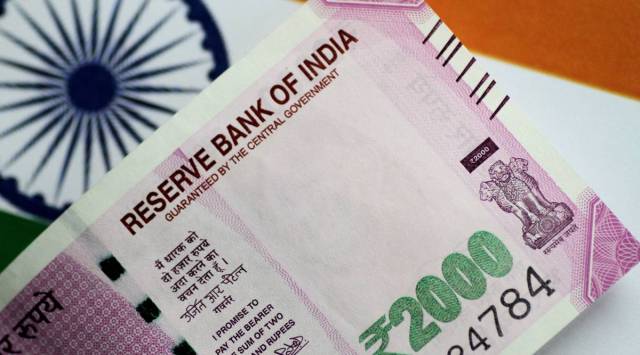Rupee breaches 80 vs US Dollar: Here’s how analysts reacted
Indian Rupee vs US Dollar: In the early trade on Tuesday, the rupee fell over 8 paise to touch a fresh all-time low of 80.06 against the greenback in early trade, Bloomberg data showed.
 Indian Rupee Against US Dollar: An Indian rupee note is seen in this illustration photo June 1, 2017. (REUTERS/Illustration/File Photo)
Indian Rupee Against US Dollar: An Indian rupee note is seen in this illustration photo June 1, 2017. (REUTERS/Illustration/File Photo)Dollar vs Rupee Today: The rupee fell below the psychological mark of 80 against the US dollar to hit a new record low in the morning deals on Tuesday. The local currency fell over 8 paise to touch a fresh all-time low of 80.06 against the greenback in early trade, Bloomberg data showed.
According to a PTI report, the rupee on Monday had declined below 80 against the US currency for the first time during intra-day spot trade, but it had ended just above the key psychological mark, slipping 16 paise to 79.98.
The Indian rupee has been under pressure so far this year due to multiple factors – rising crude and other commodity prices that spiked in the wake of the Russia-Ukraine war, Foreign Institutional Investors (FIIs) pulling out money from the domestic equity markets and a ballooning trade deficit. This apart the US dollar too has strengthened over the past few months as the US Federal Reserve hiked its benchmark lending rates by an overall 150 basis points (bps) in its past three meetings this year.
Here’s how market analysts reacted:
Gaurang Somaiya, Forex & Bullion Analyst at Motilal Oswal Financial Services
“Rupee fell as broader strengthening in the dollar continued ahead of the important FOMC policy statement that will be released next week. The expectation is that the Fed could raise rates by another 75 bps and maintain a hawkish stance. On the domestic front, trade deficit continued to widen and that also is weighing on the rupee. We expect the USDINR (Spot) to trade with a positive bias and quote in the range of 79.70 and 80.20.”
Dilip Parmar, Research Analyst, HDFC Securities
“The Indian rupee plunged to 80 in early trading today but was unable to hold the level as RBI seems to be active in the market to restrict the loss after yesterday’s underperformance among Asian currencies. The overnight strength in the dollar index, weaker macro environments and recovery in crude oil prices could weigh on the rupee. Looking at the overall direction of the dollar, any retracement on account of intervention might be temporary as RBI may not favour changing the rupee directions. Spot USDINR is having resistance at 80.10 and 80.50 while near-term support is placed at 79.70 and 79.25.”
Jateen Trivedi, VP-Research Analyst at LKP Securities
“Rupee his below 80.05 against the dollar as crude price rise from $100 failing to stay below $100 send a negative signal to rupee. The lack of intervention from RBI could also weigh on sentiments on rupee weakness. Rupee weakness can continue till the time it trades below 79.25 in short-term basis towards 80.50-80.75 zone. Dollar index staying above 105 also keeps added pressure on rupee. Further crude prices action along with FII’s inflow outflows shall also give cues to rupee moves.”
Punit Patni, Equity Research Analyst at Swastika Investmart
“The rupee has finally breached the 80 mark, a key psychological level. The rupee is expected to further slide due to the current severe rate hike by the US Fed, relentless selling by foreign investors, and the rising demand for the USD due to its safe haven status. Nevertheless, the RBI is aware of the falling rupee quagmire and could take actions to curb the further depreciation, thus we expect further downside to 81 to 81.5 levels.”
Hitesh Jain, Senior Vice President – Institutional Research at YES Securities
“INR has been under steady depreciation pressure throughout this calendar year, courtesy of monetary policy tightening by the DM economies and the consequent FPI outflows from capital markets. India’s widening trade gap and capital outflows also raised the risks for the rupee. Nevertheless, RBI is aggressively intervening in FX markets to stem the weakness in INR, resorting to sell/buy swaps in the spot and forward market. Moreover, there has been a slew of measures taken by the central bank and the government to boost inflows of Forex and arrest the Rupee fall. In terms of the INR outlook for the rest of this calendar year, we sense that the worst is priced in the currency, with the value likely to be peaking around 80.5-81 against the greenback. We say this because there is a growing indication that inflation across the globe has peaked given the wide retreat in food prices, oil and other industrial commodities. Stress in the global supply chain is also reported to have eased, while global aggregate demand is slowing, manifested by a downgrade in global economic forecasts. Consequentially, markets are tapering the expectations on the quantum of Fed rate hikes, which can be characterised by a retracement in US 10yr yields to 2.9% from the peak of 3.4%. The buoyancy in the dollar index seems to be petering out, wherein Euro is now seeing a strong reversal from the parity. On India’s foreign capital portfolio flows as well, July trends show FII outflows from the Equity markets have slowed during the first fortnight, while Indian markets have managed to fetch some gains during the last 30 days, even when pain persists in global equities. Perhaps a change in trend indicates FIIs are having a change of heart for India. All these developments allude to lesser downward pressure on the INR, with the USDINR due for some mean reversion or possibly a consolidation around the 79 mark.”


- 01
- 02
- 03
- 04
- 05




























